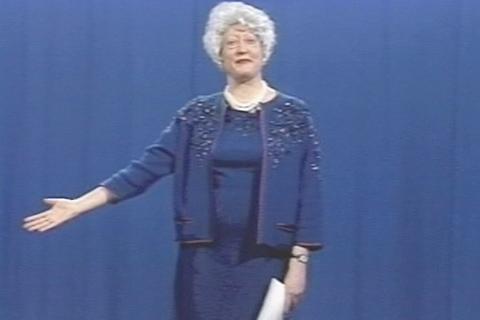Art Gallery Presents U.S. Debut of ‘Martha Wilson: Staging of the Self,’ through Nov. 4

Arcadia University Art Gallery is pleased to present the U.S. debut of Martha Wilson: Staging the Self, a touring exhibition organized by Independent Curators International (ICI) on view from Aug. 24 through Nov. 4. (Visit exhibition website.)
Surveying 40 years of performances, videos, and photo-text works by Wilson—including her musical collaborations in the group DISBAND—the exhibition also includes material the artist selected from the archives of Franklin Furnace, the non-profit art organization Wilson founded at 112 Franklin St. in Tribeca in 1976 and still directs as a virtual institution.
The opening event, “Staging the Self (Transformations, Invasions and Pushing Boundaries),” a lecture by Martha Wilson, takes place Wednesday, Sept. 5, at 6:30 p.m. in the Commons Great Room, followed by a reception in the Art Gallery, Spruance Fine Arts Center.
Materializing “Six Years”: Lucy R. Lippard and the Emergence of Conceptual Art, a lecture by Catherine Morris, curator of the Elizabeth A. Sackler Center for Feminist Art, Brooklyn Museum, takes place on Tuesday, Oct. 30, at 6:30 p.m. in Stiteler Auditorium, Murphy Hall.
Wilson, a native of Newtown, Pa., who has lived in New York since 1974, is esteemed for both her solo artistic production and her maverick efforts to champion creative forms that are “vulnerable due to institutional neglect, their ephemeral nature, or politically unpopular content.” Described by New York Times critic Holland Cotter as one of “the half-dozen most important people for art in downtown Manhattan in the 1970s,” Wilson continues to remain what exhibition curator Peter Dykhiuis calls a “creative presence as an arts administrator and cultural operative.”
Written into and out of art history according to the theories and convictions of the time, Wilson first gained notoriety thanks to the attention of curator Lucy R. Lippard, who placed Wilson’s early efforts within the context of conceptual art and the work of women artists. Commenting on Wilson’s first projects, art historian Jane Wark wrote in 2001:
In her conceptually based performance, video and photo-text works, Wilson masqueraded as a man in drag, catalogued various body parts, manipulated her appearance with makeup and explored the effects of “camera presence” in self-representation. Although this work was made in isolation from any feminist community, it has been seen to contribute significantly to what would become feminism’s most enduring preoccupations: the investigation of identity and embodied subjectivity.
Wilson’s early work is now considered prescient. In addition to being regarded by many as prefiguring some of the ideas proposed in the 1980s by philosopher Judith Butler about gender performativity, many of her photo-text pieces point to territory later mined by Cindy Sherman, among many other contemporary artists.
In addition to including 26 framed examples of her photo-based work, the exhibition features comprehensive documentation of Wilson’s performance projects, beginning with a suite of videos made in 1972 in which Wilson speaks directly to the camera to demonstrate its impact on the identity she is projecting in real time. Wilson’s work with DISBAND, an all-female vaudevillian-punk group (including Ilona Granet, Donne Henes, Ingrid Sischy and Diane Torr) is represented by a selection of short pieces that follow the band’s evolution from 1978 to 1982. These 19 chants and skipping songs (accompanied by hand clapping and sounds made by domestic, noise-generating objects) irreverently insert the female voice into the male forum of New York punk. Wilson’s satirical interpretations of presidential “First Ladies” are perhaps her most iconic impersonations. Starting in 1985 with Nancy Reagan and continuing through the culture wars with Barbara Bush and Tipper Gore, these performances reflect the many battles Wilson fought to protect free speech and government funding for Franklin Furnace while exposing the biases of right-wing ideologies. Immersed in the topical details of their time, they remain fresh, biting, and pertinent.
By encompassing the complex nature of Wilson’s multifaceted activities, Staging the Self encapsulates the key debates in feminist and socially-engaged practices wherein identity and positioning are not only self-defined but are also negotiated, disputed, and constantly re-imagined. Helping to inform the questions of selfhood and contested histories behind the exhibition is the inclusion of the Martha Wilson Sourcebook: 40 Years of Reconsidering Performance, Feminism, Alternative Spaces. Published by ICI last year, the book was recently named by Specific Object (New York), as its 2011 Publication of the Year.
Responding to the wide scope of Wilson’s career, Dykhuis has assembled a diverse collection of works that is intended as a flexible, modular, and collaborative exhibition. At Arcadia, the material is arranged chronologically, allowing visitors to track the development of Wilson’s artistic practice as well as the history of Franklin Furnace, which is represented by documentation and ephemera representing 30 projects from 1976 to 2006. These include works by Vito Acconci, Sophie Calle, Willie Cole, Nicole Eisenman, Karen Finley, Tehching Hsieh, Jenny Holzer, Barbara Kruger, William Pope.L., Louise Lawler, Sherrie Levine, Ana Mendieta, Linda Montano, Shirin Neshat, Dan Perjovschi, Martha Rosler, Julia Scher, Annie Sprinkle, and William Wegman, among many others. Also included is a display of 40 artist’s books, the first art form supported by Franklin Furnace (along with performance art and installation). The examples obtained by Wilson grew to become the largest collection of artists’ books produced internationally after 1960 held in the United States before it was acquired by the Museum of Modern Art in 1994.
Martha Wilson: Staging the Self is a traveling exhibition organized and circulated by Independent Curators International (ICI), New York. Guest curator for the exhibition is Peter Dykhuis. The exhibition, tour, and catalogue are made possible in part by the National Endowment for the Arts, The Andy Warhol Foundation for the Visual Arts, The Horace W. Goldsmith Foundation, The Cowles Charitable Trust, the ICI Board of Trustees, and ICI Benefactors Barbara and John Robinson.

